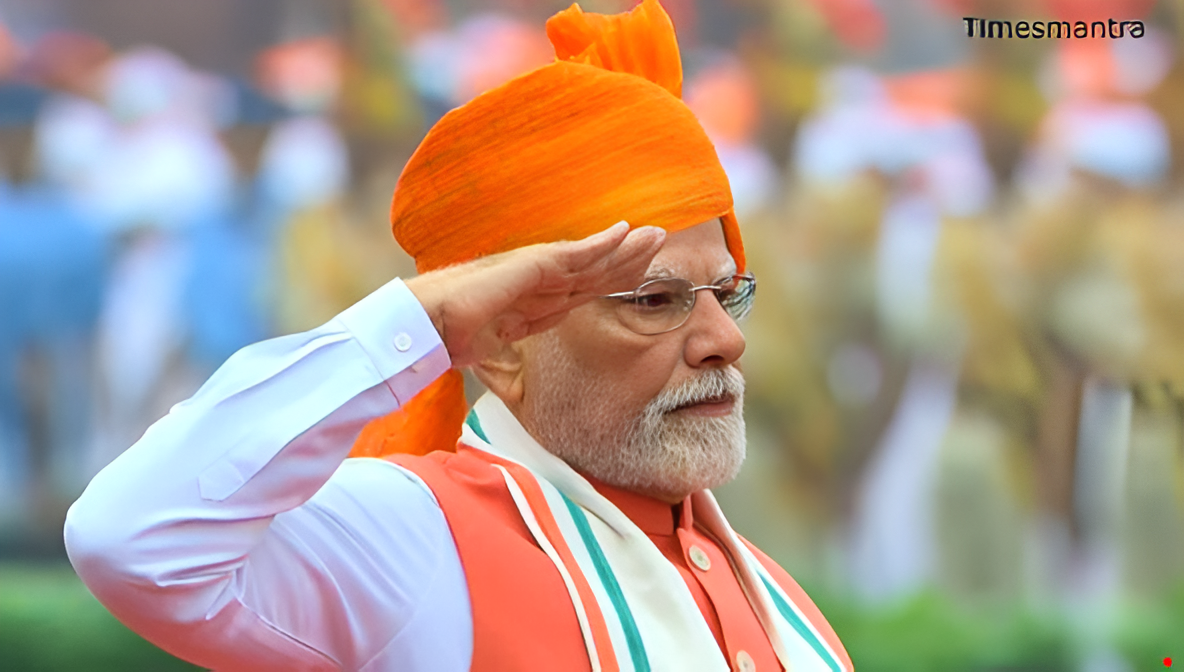A Marathon of Oratory: PM Modi Sets New Records with 103-Minute Independence Day Address
In a moment that combined endurance with a bold vision for the nation, Prime Minister Narendra Modi delivered his longest-ever Independence Day speech from the ramparts of the historic Red Fort. Clocking in at an impressive 103 minutes (one hour and 43 minutes), the address on India’s 79th Independence Day not only surpassed his own previous record of 98 minutes, set just last year, but also cemented his reputation for delivering comprehensive and detailed orations on this significant national occasion.
This year’s speech was a powerful and wide-ranging narrative that touched on key policy announcements, national pride, and a clear roadmap for India’s future. It was the Prime Minister’s 12th consecutive address from the Red Fort, a milestone that also saw him break the record held by former Prime Minister Indira Gandhi, placing him second only to Jawaharlal Nehru’s 17 consecutive speeches.
A Look at the Numbers: A New Benchmark in Political Oratory
Prime Minister Modi has consistently been known for his lengthy and detailed Independence Day addresses, a departure from many of his predecessors who often kept their speeches concise.
- A New Record: The 103-minute speech on August 15, 2025, is the longest by any Indian Prime Minister, surpassing his previous record of 98 minutes from last year.
- Breaking his Own Records: Before this year’s address, PM Modi’s longest speech was 98 minutes in 2024, followed by 96 minutes in 2016. His shortest speech from the Red Fort was 56 minutes in 2017.
- Historical Context: In comparison, India’s first Prime Minister, Jawaharlal Nehru, delivered a 72-minute speech in 1947, which was the previous record before Modi. Other leaders like Manmohan Singh and Atal Bihari Vajpayee typically delivered shorter addresses, with their speeches often lasting between 25 and 55 minutes.
The length of the speech is not merely a number; it is a reflection of the Prime Minister’s style of governance, which focuses on providing a detailed account of the government’s achievements and outlining specific, actionable plans for the future.
A Roadmap for a ‘Viksit Bharat’ (Developed India)
The 103-minute address was a dense tapestry of policy announcements and strategic initiatives aimed at realizing the vision of a “Viksit Bharat” by 2047. The speech’s duration was a necessity, given the breadth of topics covered, from economic reforms to national security.
Some of the key announcements that contributed to the length and substance of the speech included:
- Economic Reforms: The Prime Minister announced “next-generation GST reforms” as a “big gift on Diwali,” aimed at simplifying the tax structure and reducing rates on essential goods.
- Technology & Self-Reliance: He highlighted the progress of the India Semiconductor Mission, promising that the country’s first indigenously manufactured chips would be available by the end of 2025.
- Youth Employment: A landmark ₹1 lakh crore scheme for the youth, the Pradhan Mantri Viksit Bharat Rojgar Yojana, was announced to provide financial support to individuals securing their first private sector job.
- National Security: The Prime Minister took a tough stance on national security, announcing “Mission Sudarshan Chakra,” a new defense system, and sending a strong message to neighboring countries on the Indus Waters Treaty, declaring that “blood and water will not run together anymore.”
By detailing these initiatives, the Prime Minister used the platform not just for ceremonial purposes but as a national briefing, communicating a comprehensive roadmap directly to the citizens.
A Message of Continuity and Leadership
This year’s speech marked the beginning of PM Modi’s second term after his party’s impressive victory in the recent elections. The speech reflected a narrative of continuity, building on the foundation of “reform, perform, and transform” that he has emphasized throughout his tenure.
The consistent, and often lengthy, nature of his speeches has become a signature part of his political leadership. It serves to:
- Engage the Public: It keeps the public informed and engaged with the government’s agenda.
- Set the Narrative: It allows the Prime Minister to set the national narrative, focusing on themes of development, self-reliance, and national pride.
- Build a Legacy: With each passing year, the length and content of his speeches contribute to a documented legacy of his tenure, detailing the progress and challenges along the way.
As the tricolor fluttered from the Red Fort, PM Modi’s 103-minute address was a testament to both his oratorical stamina and his ambitious vision for India’s future. It was a speech that broke records, but more importantly, it was a message that reinforced the government’s commitment to a detailed and all-encompassing path towards a developed and self-reliant nation.
